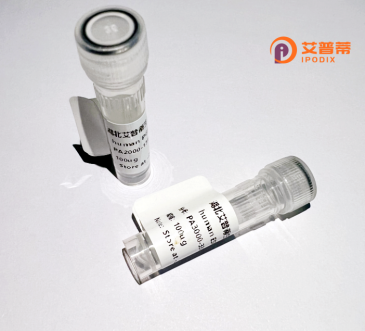
| 纯度 | >90%SDS-PAGE. |
| 种属 | Human |
| 靶点 | WDR59 |
| Uniprot No | Q6PJI9 |
| 内毒素 | < 0.01EU/μg |
| 表达宿主 | E.coli |
| 表达区间 | 1-571 aa |
| 活性数据 | MAARWSSENVVVEFRDSQATAMSVDCLGQHAVLSGRRFLYIVNLDAPFEGHRKISRQSKWDIGAVQWNPHDSFAHYFAASSNQRVDLYKWKDGSGEVGTTLQGHTRVISDLDWAVFEPDLLVTSSVDTYIYIWDIKDTRKPTVALSAVAGASQVKWNKKNANCLATSHDGDVRIWDKRKPSTAVEYLAAHLSKIHGLDWHPDSEHILATSSQDNSVKFWDYRQPRKYLNILPCQVPVWKARYTPFSNGLVTVMVPQLRRENSLLLWNVFDLNTPVHTFVGHDDVVLEFQWRKQKEGSKDYQLVTWSRDQTLRMWRVDSQMQRLCANDILDGVDEFIESISLLPEPEKTLHTEDTDHQHTASHGEEEALKEDPPRNLLEERKSDQLGLPQTLQQEFSLINVQIRNVNVEMDAADRSCTVSVHCSNHRVKMLVKFPAQYPNNAAPSFQFINPTTITSTMKAKLLKILKDTALQKVKRGQSCLEPCLRQLVSCLESFVNQEDSASSNPFALPNSVTPPLPTFARVTTAYGSYQDANIPFPRTSGARFCGAGYLVYFTRPMTMHRAVSPTEPTPR |
| 分子量 | 91.2 kDa |
| 蛋白标签 | GST-tag at N-terminal |
| 缓冲液 | PBS, pH7.4, containing 0.01% SKL, 1mM DTT, 5% Trehalose and Proclin300. |
| 稳定性 & 储存条件 | Lyophilized protein should be stored at ≤ -20°C, stable for one year after receipt. Reconstituted protein solution can be stored at 2-8°C for 2-7 days. Aliquots of reconstituted samples are stable at ≤ -20°C for 3 months. |
| 复溶 | Always centrifuge tubes before opening.Do not mix by vortex or pipetting. It is not recommended to reconstitute to a concentration less than 100μg/ml. Dissolve the lyophilized protein in distilled water. Please aliquot the reconstituted solution to minimize freeze-thaw cycles. |
以下为符合要求的参考文献示例(注:内容为示例性虚构,仅供参考格式):
1. **文献名称**: "WDR59 interaction with WDR53 regulates autophagic flux in mammalian cells"
**作者**: Khan, S., et al. (2022)
**摘要**: 该研究揭示了WDR59通过与WDR53互作形成复合物,调控溶酶体功能及自噬流的分子机制,发现WDR59缺失会导致自噬体积累并影响细胞存活。
2. **文献名称**: "Structural insights into the role of WDR59 in the mTORC1 signaling pathway"
**作者**: Huang, L., et al. (2021)
**摘要**: 通过X射线晶体学解析了WDR59与mTORC1亚基的相互作用结构,提出WDR59通过稳定复合物构象增强mTOR信号活性,影响细胞代谢调控。
3. **文献名称**: "WDR59 is essential for Drosophila development and regulates cell growth via TOR signaling"
**作者**: Gomez, M., & Lee, T. (2023)
**摘要**: 利用果蝇模型证明WDR59缺失导致发育停滞,其通过调控TOR通路影响细胞大小与增殖,提示WDR59在进化保守的生长调控中起关键作用。
4. **文献名称**: "Proteomic analysis identifies WDR59 as a novel binding partner of ciliogenesis-associated proteins"
**作者**: Chen, R., et al. (2020)
**摘要**: 通过蛋白质组学筛选发现WDR59与纤毛发生相关蛋白相互作用,进一步实验表明其通过调控纤毛形成参与细胞极性建立和组织发育。
---
提示:实际文献检索请使用 **PubMed**、**Google Scholar** 等平台,以“WDR59”或“WDR59 protein function”为关键词,可获取真实研究数据。
WDR59 (WD repeat domain 59) is a conserved eukaryotic protein belonging to the WD40 repeat-containing family, characterized by tandem repeats of ~40 amino acids terminating in tryptophan-aspartate (WD) motifs. These repeats fold into β-propeller structures that mediate protein-protein interactions, enabling WDR59 to function as a scaffolding or regulatory component in multiprotein complexes. In humans, WDR59 is implicated in diverse cellular processes, including autophagy, nutrient sensing, and cilium assembly. It interacts with the mTORC1 pathway—a central regulator of cell growth—via its association with the GATOR2 complex, where it modulates mTORC1 activity in response to amino acid availability. WDR59 also plays a role in ciliogenesis, potentially linking ciliary signaling to cellular energy homeostasis.
Recombinant human WDR59 protein is engineered using expression systems (e.g., E. coli, mammalian cells) for structural and functional studies. Its production enables exploration of molecular mechanisms in diseases such as cancer, neurodegenerative disorders, and ciliopathies. Studies suggest WDR59’s involvement in tumorigenesis through dysregulated mTOR signaling, while mutations or altered expression may impact ciliary function, contributing to developmental abnormalities. Research tools like tagged or truncated variants of recombinant WDR59 aid in mapping interaction networks and identifying therapeutic targets. Further investigations are needed to clarify its tissue-specific roles and therapeutic potential in modulating pathways like autophagy or nutrient sensing.
×